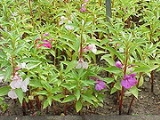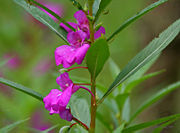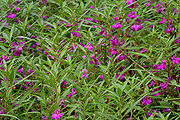
Impatiens balsamina
Encyclopedia


Impatiens
Impatiens is a genus of about 850–1,000 species of flowering plants, widely distributed throughout the Northern Hemisphere and tropics. Together with the puzzling Hydrocera triflora, this genus makes up the family Balsaminaceae...
native to southern Asia
Asia
Asia is the world's largest and most populous continent, located primarily in the eastern and northern hemispheres. It covers 8.7% of the Earth's total surface area and with approximately 3.879 billion people, it hosts 60% of the world's current human population...
in India
India
India , officially the Republic of India , is a country in South Asia. It is the seventh-largest country by geographical area, the second-most populous country with over 1.2 billion people, and the most populous democracy in the world...
and Myanmar
Myanmar
Burma , officially the Republic of the Union of Myanmar , is a country in Southeast Asia. Burma is bordered by China on the northeast, Laos on the east, Thailand on the southeast, Bangladesh on the west, India on the northwest, the Bay of Bengal to the southwest, and the Andaman Sea on the south....
.It is called kamantigue in the Philippines. This species of Kalamantigue are used in teas. Boil the seeds after drying and you will get a tea.
In many English speaking countries they are known as "Touch me Not", possibly due to the ripe seed pods explosively bursting when touched.
It is an annual plant
Annual plant
An annual plant is a plant that usually germinates, flowers, and dies in a year or season. True annuals will only live longer than a year if they are prevented from setting seed...
growing to 20–75 cm tall, with a thick, but soft stem. The leaves
Leaf
A leaf is an organ of a vascular plant, as defined in botanical terms, and in particular in plant morphology. Foliage is a mass noun that refers to leaves as a feature of plants....
are spirally-arranged, 2.5–9 cm long and 1–2.5 cm broad, with a deeply toothed margin. The flower
Flower
A flower, sometimes known as a bloom or blossom, is the reproductive structure found in flowering plants . The biological function of a flower is to effect reproduction, usually by providing a mechanism for the union of sperm with eggs...
s are red, pink, purple, or white, and 2.5–5 cm diameter; they are pollinated by bees and other insects, and also by nectar-feeding birds.
Different parts of the plant are used to treat disease and skin afflctions; the leaves, seeds, and stems are also edible if cooked. Juice from balsam leaves treats warts and also snakebite
Snakebite
A snakebite is an injury caused by a bite from a snake, often resulting in puncture wounds inflicted by the animal's fangs and sometimes resulting in envenomation. Although the majority of snake species are non-venomous and typically kill their prey with constriction rather than venom, venomous...
, while the flower can be applied to burns to cool the skin. Impatiens balsamina L. has been used as indigenous medicine in Asia for the treatment of rheumatism, fractures, and fingernail inflammation. In Korean folk medicine Impatiens ('Bong Seon Wha Dae') has been used to cure constipation and acute gastritis by meat.
One in vitro
In vitro
In vitro refers to studies in experimental biology that are conducted using components of an organism that have been isolated from their usual biological context in order to permit a more detailed or more convenient analysis than can be done with whole organisms. Colloquially, these experiments...
study found Impatiens, especially the seed pod to have antibacterial activity against Multiple Antibiotic-Resistant Helicobacter pylori
Helicobacter pylori
Helicobacter pylori , previously named Campylobacter pyloridis, is a Gram-negative, microaerophilic bacterium found in the stomach. It was identified in 1982 by Barry Marshall and Robin Warren, who found that it was present in patients with chronic gastritis and gastric ulcers, conditions that were...
.
It inhibits 5alpha-reductase, so may have potential medicinal use in male BPH/LUTs
It is widely cultivated as an ornamental plant
Ornamental plant
Ornamental plants are plants that are grown for decorative purposes in gardens and landscape design projects, as house plants, for cut flowers and specimen display...
, and has become naturalised
Naturalisation (biology)
In biology, naturalisation is any process by which a non-native organism spreads into the wild and its reproduction is sufficient to maintain its population. Such populations are said to be naturalised....
and invasive
Invasive species
"Invasive species", or invasive exotics, is a nomenclature term and categorization phrase used for flora and fauna, and for specific restoration-preservation processes in native habitats, with several definitions....
on several Pacific Ocean islands.
Chemistry
Naphthoquinones; lawsone, lawsone methyl ether and methylene-3,3'-bilawsone are the main active compounds of Impatiens balsamina leaves.Balsam also contains kaempferol
Kaempferol
Kaempferol is a natural flavonol, a type of flavonoid, that has been isolated from tea, broccoli, Delphinium, Witch-hazel, grapefruit,cabbage, kale, beans, endive, leek, tomato, strawberries, grapes, brussels sprouts, apples and other plant sources. Kaempferol is a yellow crystalline solid with a...
and
Baccharane glycosides were found in the seeds.
Other links
http://www.stuartxchange.org/Kamantigi.htmlhttp://www.drugs.com/npp/jewelweed.html
http://en.wikipedia.org/wiki/Impatiens

